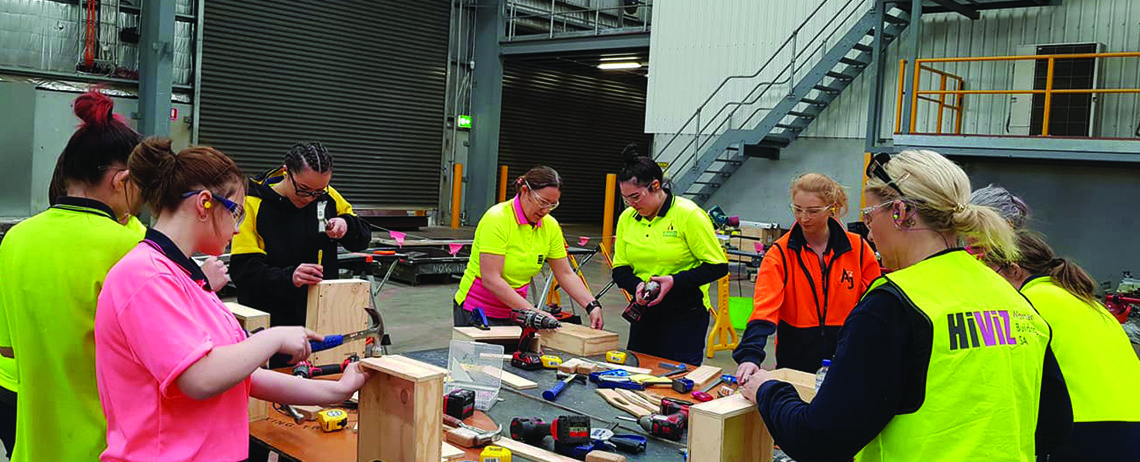‘Jobs Don’t Have a Gender’: How SALT Helps Women Pick up the Tools
SafetyCulture News | By | 30 Oct 2018 | 4 minute read

When Fi Shewring started work as a painter and decorator with her husband-to-be Peter 26 years ago, his advice was straight to the point.
“He said, ‘Wear your whites, don’t touch me, don’t call me darling.’ That was probably the best advice anybody ever gave me, because we set this parameter to work very, very professionally as a couple,” she says.
Shewring says she remembers clear as a bell the first site she worked on, with about 50 blokes. “I was painting away and a carpenter came in and he said, ‘Oh, nice to see a woman on site, that’s really cool.’ And it was the first time I really realised that this was something unusual.”
Fast-forward to 2018, and Shewring is president and co-founder of SALT, which stands for Supporting and Linking Tradeswomen. Since its inception nine years ago, its work has been manifold.
It runs workshops for primary and high school students and in communities to educate and inspire young girls and women about taking up the tools and what they can achieve. SALT also advises companies on aspects including recruitment, and offers support for individuals seeking career help.
She says the message is simple: “Jobs don’t have a gender”.
Tradeswomen make up about 2 per cent of the trades workforce, she says, but it is a number that is rising.
“Hallelujah. We’ve been working hard enough, because basically, from our point of view, we realise we needed to generate change in society. We needed to change what women thought they could do and change what society thought women could do.
“So that’s what we set out to do with the workshops. Along the way, the very least we do is give women life skills, but our prime target is to enable women to have a choice.”
She says what is important is educating women about the depth and breadth of trades that are out there, and how the trades spread right across different vocations, meaning there’s a huge array of choice for anyone wanting to begin a career in trades.
“That’s the thing,” she says. “You don’t know what you don’t know. You can’t be what you can’t see.”
Shewring is determined to make sure as many young girls and women see as much of the trades as possible, from as young an age as possible.
Companies are also realising the value in an organisation such as SALT, reaching out for guidance particularly when they realise the difference diversification can make in certain male-dominated industries.
“For our recruitment piece we decided to bring SALT to our site so if some females came it would give them the chance to use a hand tool or a power tool so they walk away with the belief that they can do it,” says then Apprentice Training Manager for Sydney Trains, Maggie Pierce.
“We went from 15 female applicants the previous year to 130 last year, meaning about 11 per cent of all applicants were female. That is unheard of. It’s about the visibility.”
Shewring says that for companies who have already started on the track of hiring women, they’re seeing the benefits very quickly.
“They’ve said, ‘We’ve started to diversify, we can see the difference it made to our workforce where it became less aggressive, it worked better. We want to continue this process but we’re finding women are not applying enough. So what can we do?’ ”
She says one of the biggest barriers, and frustrations in recruitment is often imagery. “For many companies, their imagery for recruitment is all male-based,” she says.
“They don’t need to change the wording, they need to change the imagery. And it needs to be real imagery—one thing that every person in the trades, whether you’re male or female, will pick is a model dressed up as a tradie. And when you look at the stock photos of tradeswomen, they are so sexualised, it’s disgusting.”
Shewring’s path to founding SALT is an interesting one. She studied a degree in ceramics but as a mother to five children she returned to the workforce alongside Peter so she could earn an income.
She later went to TAFE and gap skilled to become a qualified tradeswoman before deciding she’d also like to teach at TAFE. That’s where she developed her keen interest in the lack of women in the trades, and the reasons for it.
After some research, including a scholarship with the National Association of Women In Construction for a month-long tour of the US investigating tradeswomen there, she felt inspired to take constructive action and launched SALT with six other founders she knew from the industry. In 2012, it received funding of $25,000 from Women NSW which allowed them to get together a customised ute and trailer that they filled with tools and now take all over the countryside for workshops.
Funding since has come from the NSW Department of Education and the federal Department of Education, and things have really ramped up over the past year. Between 2009 and early 2017, they’d done 100 workshops. In the time since, they’ve done 100 more.
The aim of the organisation is to create change, she says. “So that we get to a point where Australia is actually not looking at its workforce as ‘this is men’s jobs’ and ‘this is women’s jobs’, to the point where it’s going, OK, we need people here, we need people there, and the whole gender thing is taken away.
“I’m trying to do myself out of a job. I’m trying to get to a point where we’re not needed. And we’re making inroads, but I think I’ve still got a job for a good few years yet.”
For more information, see saltaustralia.org.au.
Important Notice
The information contained in this article is general in nature and you should consider whether the information is appropriate to your specific needs. Legal and other matters referred to in this article are based on our interpretation of laws existing at the time and should not be relied on in place of professional advice. We are not responsible for the content of any site owned by a third party that may be linked to this article. SafetyCulture disclaims all liability (except for any liability which by law cannot be excluded) for any error, inaccuracy, or omission from the information contained in this article, any site linked to this article, and any loss or damage suffered by any person directly or indirectly through relying on this information.





